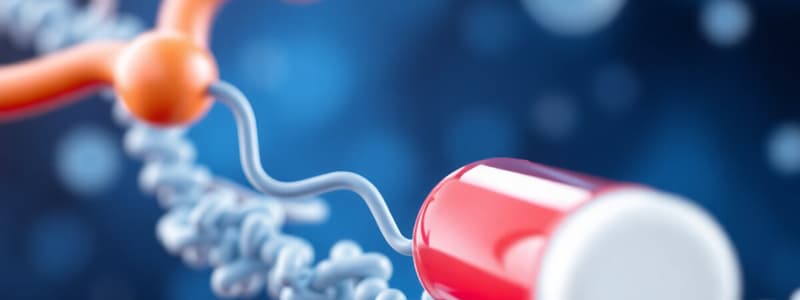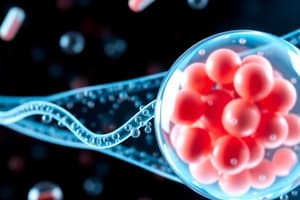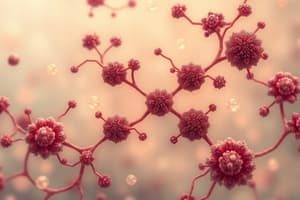Podcast
Questions and Answers
What defines the therapeutic window in pharmacokinetics?
What defines the therapeutic window in pharmacokinetics?
- The range between minimum effective concentration and maximum safe concentration (correct)
- The range between peak concentration and minimum effective concentration
- The difference between the rate of drug absorption and elimination
- The time taken to reach peak concentration and the overall area under the curve
In a non-intravenous administration of a drug, what is the maximum absorption rate represented as a percentage?
In a non-intravenous administration of a drug, what is the maximum absorption rate represented as a percentage?
- 100% (correct)
- 75%
- 50%
- 0%
At what point on the plasma concentration versus time graph does the rate of absorption equal the rate of elimination?
At what point on the plasma concentration versus time graph does the rate of absorption equal the rate of elimination?
- tmax
- AUC
- Cmax (correct)
- MEC
What happens to the absorption phase of a drug after reaching Cmax?
What happens to the absorption phase of a drug after reaching Cmax?
What characterizes the nature of elimination after complete absorption of a drug?
What characterizes the nature of elimination after complete absorption of a drug?
What is the primary mechanism by which most drugs gain access to the body?
What is the primary mechanism by which most drugs gain access to the body?
Which of the following factors does NOT influence drug distribution in the body?
Which of the following factors does NOT influence drug distribution in the body?
What role does the liver play in the metabolism of drugs?
What role does the liver play in the metabolism of drugs?
Which statement best describes the structure of cell membranes that affects drug permeability?
Which statement best describes the structure of cell membranes that affects drug permeability?
What distinguishes pharmacokinetics from pharmacodynamics?
What distinguishes pharmacokinetics from pharmacodynamics?
What is the primary barrier for water-soluble drugs when penetrating cell membranes?
What is the primary barrier for water-soluble drugs when penetrating cell membranes?
Which transport mechanism does NOT require energy?
Which transport mechanism does NOT require energy?
How does the ionization state of a drug affect its ability to cross lipid membranes?
How does the ionization state of a drug affect its ability to cross lipid membranes?
What does the lipid-aqueous drug partition coefficient indicate?
What does the lipid-aqueous drug partition coefficient indicate?
What is the significance of bioavailability in pharmacology?
What is the significance of bioavailability in pharmacology?
Which statement about active transport is correct?
Which statement about active transport is correct?
Which of the following substances is most likely to utilize endocytosis for cell entry?
Which of the following substances is most likely to utilize endocytosis for cell entry?
What factor greatly influences a drug's ionization state according to the Henderson-Hasselbalch equation?
What factor greatly influences a drug's ionization state according to the Henderson-Hasselbalch equation?
What does the term 'half-life' specifically refer to in pharmacology?
What does the term 'half-life' specifically refer to in pharmacology?
Which formulation of a drug most likely has a clinical effect based on the bioavailability graph?
Which formulation of a drug most likely has a clinical effect based on the bioavailability graph?
What pharmacokinetic parameters are significant in assessing bioequivalence?
What pharmacokinetic parameters are significant in assessing bioequivalence?
What characterizes the concept of 'steady state' in drug dosing?
What characterizes the concept of 'steady state' in drug dosing?
Why is protein binding important in pharmacokinetics?
Why is protein binding important in pharmacokinetics?
What is the implication of having a difference in AUC for formulations A and B?
What is the implication of having a difference in AUC for formulations A and B?
What is a defining limit for bioequivalence in terms of AUC?
What is a defining limit for bioequivalence in terms of AUC?
Which statement accurately reflects the role of the medication's concentration at the minimum effective concentration (MEC)?
Which statement accurately reflects the role of the medication's concentration at the minimum effective concentration (MEC)?
What physiological role does blood play in the absorption of drugs?
What physiological role does blood play in the absorption of drugs?
Which parameter is essential for determining the absolute bioavailability of a drug?
Which parameter is essential for determining the absolute bioavailability of a drug?
Which factors influence the distribution of drugs in the body?
Which factors influence the distribution of drugs in the body?
In the context of volume of distribution, how is the dose related to concentration and volume?
In the context of volume of distribution, how is the dose related to concentration and volume?
Which form of a drug is capable of diffusing across biological membranes?
Which form of a drug is capable of diffusing across biological membranes?
What is the impact of blood flow on drug distribution?
What is the impact of blood flow on drug distribution?
During intravenous administration, what percentage of bioavailability is typically associated with the procedure?
During intravenous administration, what percentage of bioavailability is typically associated with the procedure?
How does the concentration of drug in plasma compare to that in interstitial fluid?
How does the concentration of drug in plasma compare to that in interstitial fluid?
Which characteristic of a drug would likely result in a high volume of distribution?
Which characteristic of a drug would likely result in a high volume of distribution?
What is the primary organ responsible for the metabolism of drugs?
What is the primary organ responsible for the metabolism of drugs?
Which of the following processes increases the polarity of a drug during metabolism?
Which of the following processes increases the polarity of a drug during metabolism?
Which metabolic process involves the splitting of a drug into simpler molecules?
Which metabolic process involves the splitting of a drug into simpler molecules?
Which route is NOT considered a major pathway for drug elimination?
Which route is NOT considered a major pathway for drug elimination?
What defines the half-life of a drug?
What defines the half-life of a drug?
What term is used to describe the process of a drug crossing the glomerular filter in the kidneys?
What term is used to describe the process of a drug crossing the glomerular filter in the kidneys?
What is the significance of CYP450 enzymes in drug metabolism?
What is the significance of CYP450 enzymes in drug metabolism?
Which drug characteristic is associated with a low volume of distribution?
Which drug characteristic is associated with a low volume of distribution?
Which of these is NOT a minor pathway of drug elimination?
Which of these is NOT a minor pathway of drug elimination?
Flashcards
Biopharmaceutics
Biopharmaceutics
The study of how a drug's properties affect its absorption into the body.
Pharmacokinetics
Pharmacokinetics
The study of how the body processes a drug over time, including absorption, distribution, metabolism, and elimination.
Pharmacodynamics
Pharmacodynamics
The study of how a drug interacts with the body to produce its effects.
Passive Diffusion
Passive Diffusion
Signup and view all the flashcards
Cell Membrane
Cell Membrane
Signup and view all the flashcards
Bioavailability
Bioavailability
Signup and view all the flashcards
Cmax (Peak Concentration)
Cmax (Peak Concentration)
Signup and view all the flashcards
Tmax (Time to Peak Concentration)
Tmax (Time to Peak Concentration)
Signup and view all the flashcards
Therapeutic Window
Therapeutic Window
Signup and view all the flashcards
Half-Life
Half-Life
Signup and view all the flashcards
Lipid-aqueous drug partition coefficient
Lipid-aqueous drug partition coefficient
Signup and view all the flashcards
Ionization state of a drug
Ionization state of a drug
Signup and view all the flashcards
Drug pKa
Drug pKa
Signup and view all the flashcards
Facilitated diffusion
Facilitated diffusion
Signup and view all the flashcards
Active transport
Active transport
Signup and view all the flashcards
Endocytosis
Endocytosis
Signup and view all the flashcards
Exocytosis
Exocytosis
Signup and view all the flashcards
Half-life (Elimination)
Half-life (Elimination)
Signup and view all the flashcards
Cmax
Cmax
Signup and view all the flashcards
Tmax
Tmax
Signup and view all the flashcards
AUC (Area Under the Curve)
AUC (Area Under the Curve)
Signup and view all the flashcards
Bioequivalence
Bioequivalence
Signup and view all the flashcards
Steady State
Steady State
Signup and view all the flashcards
Protein Binding (Drug)
Protein Binding (Drug)
Signup and view all the flashcards
Drug Absorption
Drug Absorption
Signup and view all the flashcards
Sink Condition
Sink Condition
Signup and view all the flashcards
Absolute Bioavailability
Absolute Bioavailability
Signup and view all the flashcards
Drug Distribution
Drug Distribution
Signup and view all the flashcards
Plasma
Plasma
Signup and view all the flashcards
Interstitial Fluid
Interstitial Fluid
Signup and view all the flashcards
Intracellular Fluid
Intracellular Fluid
Signup and view all the flashcards
Volume of Distribution (V)
Volume of Distribution (V)
Signup and view all the flashcards
What is the volume of distribution?
What is the volume of distribution?
Signup and view all the flashcards
Why do lipophilic drugs have higher Vd?
Why do lipophilic drugs have higher Vd?
Signup and view all the flashcards
Why do water-soluble drugs have lower Vd?
Why do water-soluble drugs have lower Vd?
Signup and view all the flashcards
What is biotransformation?
What is biotransformation?
Signup and view all the flashcards
What is drug metabolism?
What is drug metabolism?
Signup and view all the flashcards
Where does drug metabolism mostly happen?
Where does drug metabolism mostly happen?
Signup and view all the flashcards
How does the body eliminate drugs?
How does the body eliminate drugs?
Signup and view all the flashcards
What is the half-life of a drug?
What is the half-life of a drug?
Signup and view all the flashcards
How does half-life influence drug dosing?
How does half-life influence drug dosing?
Signup and view all the flashcards
What is the importance of CYP450 enzymes?
What is the importance of CYP450 enzymes?
Signup and view all the flashcards
Study Notes
Biopharmaceutics
- Study of how drug properties (dosage form, route), affect drug absorption rate and extent
- Pharmacokinetics: Time course of drug absorption, distribution, metabolism, elimination
- Pharmacodynamics: Biochemical and physiological drug effects
Absorption
- Passive diffusion: Movement down concentration gradient across membrane without carrier proteins; not saturable, low specificity. Majority of drugs use this method.
- Cell membranes: Lipid bilayer barrier mostly impermeable to water-soluble molecules (ions)
- Polar molecules: Low permeability across lipid bilayers
- Facilitated diffusion: Carrier proteins required, saturable process.
- Active transport: Energy-dependent movement against concentration gradient; carrier proteins involved. Important for larger molecules.
- Endocytosis and exocytosis: Processes for moving large molecules across membranes.
Bioavailability
- Amount of drug reaching systemic circulation
- Dependent on dosage form and administration route
- Therapeutic response dependent on adequate drug concentration at site of action
- Bioavailability measured as the area under the blood plasma concentration-time curve (AUC)
Single oral dose
- Initial rise = absorption phase (absorption rate > elimination)
- Peak (Cmax)= absorption rate = elimination rate
- Elimination phase = elimination rate > absorption rate
- Plasma concentration decline follows exponential curve
- Minimum effective concentration (MEC): Lowest drug concentration for pharmacological effect
- Maximum safe concentration (MSC): Highest concentration without adverse effects
- Therapeutic window: Range of concentrations between MEC & MSC
Factors influencing bioavailability
- Pharmacokinetic parameters: Cmax, Tmax, AUC, half-life
Drug absorption for 3 formulations of the same drug
- Similar AUC for A and B
- Different actions, results (different Cmax and tmax).
Bioequivalence
- Comparing two dosage forms to determine if they're equivalent in terms of rate and extent of absorption
- Use AUC, Cmax, and tmax as parameters
- Limits (80-120%) differences acceptable based on safety and therapeutic effects
- Regular drug dosing: Accumulation and steady state
Steady State
- Drug input equals elimination during the dosing interval.
- Accumulation of drug occurs until concentration does not increase over time.
Protein Binding
- Drugs may bind to plasma proteins, reducing free (active) drug concentration.
Oral vs. Intravenous Administration
- Oral administration: Absorption process influences drug concentration in plasma.
- Intravenous (IV): 100% of the dose is available directly into blood stream
Metabolism
- Biotransformation: Changes drug into a different form.
- Many possible changes – oxidation, reduction, conjugation, cleavage.
- Usually increased hydrophilicity improves elimination/excretion.
- Primarily in liver but also occurs in kidneys, lungs, GI tract.
Elimination
- Major sites of elimination: Kidneys, liver; Minor sites: Lungs, sweat, saliva.
- Kidney: Filtration, secretion of metabolites
- Liver: Metabolism to more polar compounds for excretion.
Half-life
- Time taken for drug concentration to fall by 50%
- Important for frequency of dosing
Volume of distribution (Vd)
- Volume theoretically required to contain the entire dose of drug in the body at the same concentration measured in plasma
- Influenced by solubility in water/tissues & drug binding to plasma/tissues
Absolute bioavailability
- Fraction of administered dose absorbed into systemic circulation relative to IV dose.
Studying That Suits You
Use AI to generate personalized quizzes and flashcards to suit your learning preferences.




